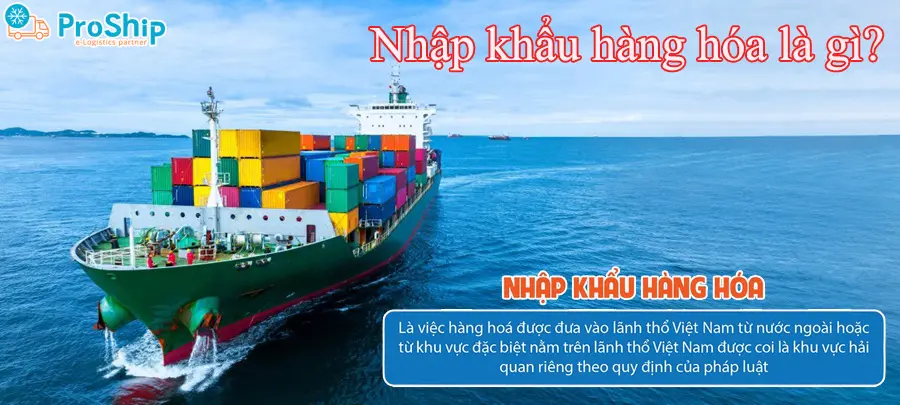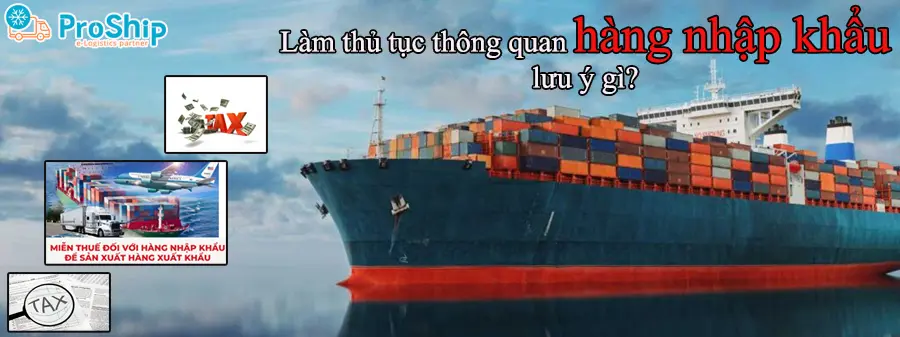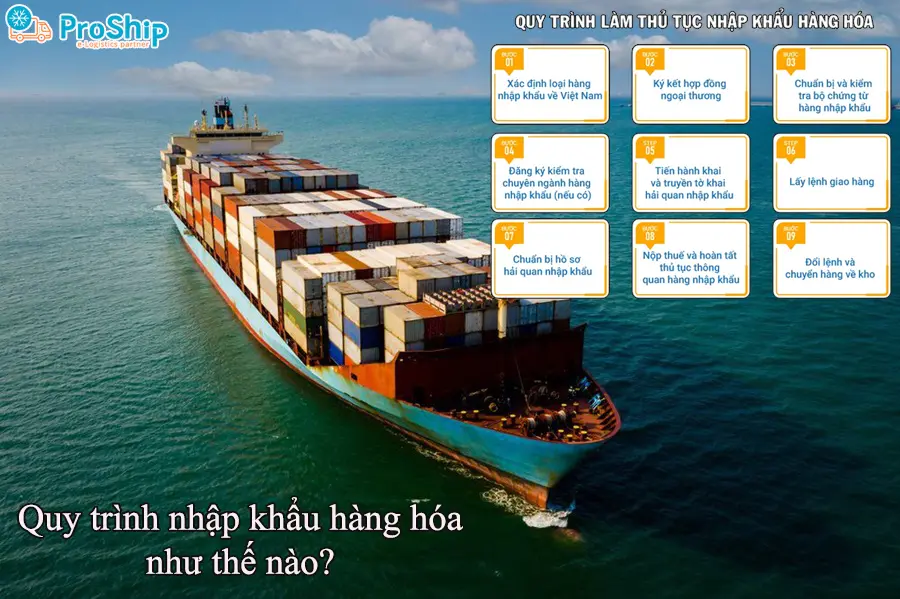x Businesses and business households need to import goods to the country to do business, trade, ... but do not know the process of carrying out customs procedures to import goods?
x You are interested and want to learn more about what the concept of importing goods is?
x You wonder what to note when importing goods, preparing documents and papers related?
Currently, the understanding of the process of importing goods is really essential. In this article, Proship.vn we will update step by step importing to Vietnam so that business households and businesses can grasp timely and apply properly.
What is import of goods?
Importing goods is the transfer of goods from abroad into the territory of Vietnam or from special areas in the territory of Vietnam is considered a separate customs sector in accordance with the law.

Regulations on importing goods are clearly stated in the Law on Foreign Trade Management 2017. Accordingly, imported goods subject to inspection include:
“Imported goods must apply technical and quarantine measures specified in Articles 61, 62, 63, 64 of the Law on Foreign Trade Management
Imported goods are potentially or potentially unsafe according to warning information from international, regional and foreign organizations, which must be tested strictly.
Imported goods were discovered by the agency that was inappropriate and must be strengthened in accordance with the law ”
Note when carrying out customs clearance procedures
When checking in goods, businesses should note:
- Tax rate: When the person using IDA, the system will take the tax rate at the expected date of IDC declaration to fill out;
- Taxable value: If the KBHQ people perform the registration of declaration and declaration of import information on the same day, there will be the same tax rate. If the procedure in 2 days has different rates, the business will report an error. At that time, the customs declarator used the IDB profession to report it;
- Each declaration is up to 50 items, more than many declarations must be used and linked by the branch number of the declaration;
- Tax and tax reduction goods: Enterprises should pay attention to ensure the benefits when declaring on the system;

- VAT -bearing goods: Enterprises need to enter the VAT tax rate in the screen available on the screen to register for import declaration;
- Enterprises are not eligible for registration: The system will refuse to issue the number of declarations and error reports;
- Register for a separate guarantee before issuing the number of declarations: The enterprise needs to be sure of the bill of lading must match the amount of bill of lading in the input screen;
- If the same item is different, the declaration must declare on many declarations to correspond to each tax payment term.
The process of importing goods into Vietnam
The process of importing goods is conducted as follows:
Step 1: Determine the type of imported goods
The type of enterprise determines the type of imported goods belonging to which commodity group, whether it is prohibited or is that item need to apply for an import license, ... After determining, the business must be implemented At the request of that item.
Step 2: Sign a foreign trade contract
Thereby legalizing transactions between the two sides. Foreign trade contracts are required in dossiers throughout the import process. The contents of the contract must be clearly recorded, detailed, complied with the law and often include the name of the item, quantity, weight, price, packaging, ...
Step 3: Check the goods vouchers
Before entering a shipment, the business requires the partner to prepare documents as well as monitor the packaging process and update information from them.
Enterprises applying for import licenses (if any), applicable to imports of sea goods, airways, insurance (if any) ... and must prepare documents:
- Sale Contract: Trade contract;
- Bill of Lading: bill of bill of bill;
- Commercial Invoice: Commercial invoice;
- Packing List: Packaging slip;
- C/O: Certificate of origin of shipment;
- Along with other relevant papers.
Step 4: Receive a notice of goods to and register for a specialized inspection
If the imported goods on the list of goods must be checked, it is a mandatory procedure. After the business receives the arrival notice (Arrival notice), the business must register for a specialized inspection.
Step 5: Declaration and transmission of customs declarations
After receiving the arrival notice, the enterprise declared the customs declaration at the General Department of Customs of Vietnam or on the VNACCS system of the Customs Department. After finishing, the business will send the declaration, the system will check. Businesses wait until the return results will take the next step.

Step 6: Take Delivery Order (Delivery Order)
Businesses who want to have delivery orders must prepare a full set of documents and take them to the carrier:
- Copy of ID/CCCD;
- Copy of bill of lading;
- The original bill was certified by the company leader;
- Fee.
Step 7: Prepare the customs records
Customs records include the papers:
- Referral;
- Channeling declaration;
- Invoice;
- Packing list;
- Bill of Lading;
- Other essential documents (C/O, bill, import license, ...).
When presenting records for customs, if the documents are valid. Customs will conduct customs clearance on the system.
Step 8: Pay taxes and complete customs procedures
After the customs declaration is approved, businesses will pay taxes. For imported goods, enterprises must pay 2 types of VAT and import tax. In addition, with some specific items, businesses must pay more environmental taxes and special consumption taxes:
- Green flow declaration: Enterprises pay taxes and taxes can print barcodes and conduct liquidation and receipt of goods;
- Gold flow declaration: Pay taxes before or after carrying out procedures for opening declarations, opening declarations, liquidating and receiving goods;
- Red flow declaration: Similar to the golden stream but in the opening of the actual declaration, there are more steps to check the actual inspection of goods.
Step 9: Procedures to change orders and transfer goods to storage
At this time, businesses must note:
- Transportation means to bring goods back;
- Warehouse and dock to preserve goods.
Step 10: Store records and vouchers
The stored documents include:
- Customs dossiers, additional dossiers, dossiers of registration of duty -free goods, dossiers of use of duty -free goods use;
- Dossiers for consideration of tax exemption, tax reduction, tax refund, non -collected tax;
- Dossiers of proposal to handle taxes, late payment, overpaid fines, ...;
- Transport vouchers, packaging cards, technical documents, ...;
- Accounting books and vouchers.
Above is the process of importing goods by Proship in detail. Businesses or business households specialize in importing goods to Vietnam for business, trade, consumption but do not know the regulations on customs procedures, prepare documents of import documents, ... Again the article. And if there is a need to hire KBHQ services, customs agents, multimodal transport, ... Contact immediately 0909 344 247 .
